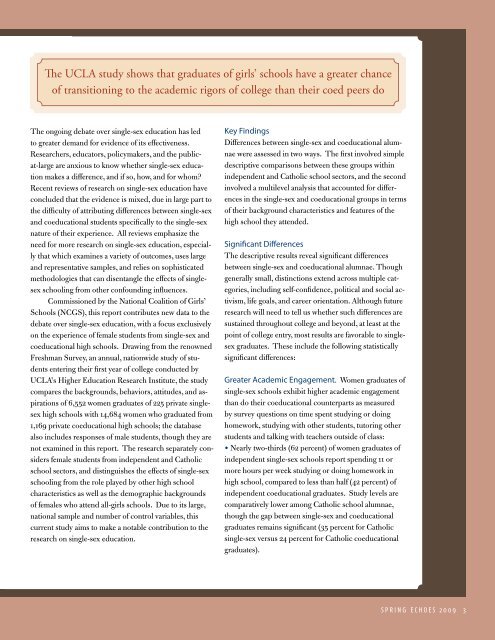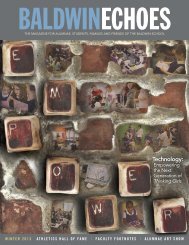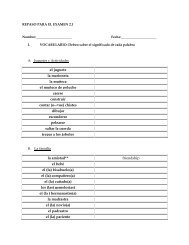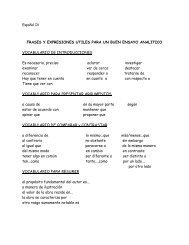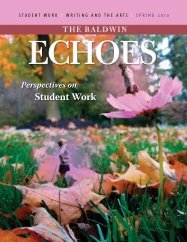Spring 2009 - Baldwin School
Spring 2009 - Baldwin School
Spring 2009 - Baldwin School
Create successful ePaper yourself
Turn your PDF publications into a flip-book with our unique Google optimized e-Paper software.
The UCLA study shows that graduates of girls’ schools have a greater chance<br />
of transitioning to the academic rigors of college than their coed peers do<br />
The ongoing debate over single-sex education has led<br />
to greater demand for evidence of its effectiveness.<br />
Researchers, educators, policymakers, and the publicat-large<br />
are anxious to know whether single-sex education<br />
makes a difference, and if so, how, and for whom?<br />
Recent reviews of research on single-sex education have<br />
concluded that the evidence is mixed, due in large part to<br />
the difficulty of attributing differences between single-sex<br />
and coeducational students specifically to the single-sex<br />
nature of their experience. All reviews emphasize the<br />
need for more research on single-sex education, especially<br />
that which examines a variety of outcomes, uses large<br />
and representative samples, and relies on sophisticated<br />
methodologies that can disentangle the effects of singlesex<br />
schooling from other confounding influences.<br />
Commissioned by the National Coalition of Girls’<br />
<strong>School</strong>s (NCGS), this report contributes new data to the<br />
debate over single-sex education, with a focus exclusively<br />
on the experience of female students from single-sex and<br />
coeducational high schools. Drawing from the renowned<br />
Freshman Survey, an annual, nationwide study of students<br />
entering their first year of college conducted by<br />
UCLA’s Higher Education Research Institute, the study<br />
compares the backgrounds, behaviors, attitudes, and aspirations<br />
of 6,552 women graduates of 225 private singlesex<br />
high schools with 14,684 women who graduated from<br />
1,169 private coeducational high schools; the database<br />
also includes responses of male students, though they are<br />
not examined in this report. The research separately considers<br />
female students from independent and Catholic<br />
school sectors, and distinguishes the effects of single-sex<br />
schooling from the role played by other high school<br />
characteristics as well as the demographic backgrounds<br />
of females who attend all-girls schools. Due to its large,<br />
national sample and number of control variables, this<br />
current study aims to make a notable contribution to the<br />
research on single-sex education.<br />
Key Findings<br />
Differences between single-sex and coeducational alumnae<br />
were assessed in two ways. The first involved simple<br />
descriptive comparisons between these groups within<br />
independent and Catholic school sectors, and the second<br />
involved a multilevel analysis that accounted for differences<br />
in the single-sex and coeducational groups in terms<br />
of their background characteristics and features of the<br />
high school they attended.<br />
Significant Differences<br />
The descriptive results reveal significant differences<br />
between single-sex and coeducational alumnae. Though<br />
generally small, distinctions extend across multiple categories,<br />
including self-confidence, political and social activism,<br />
life goals, and career orientation. Although future<br />
research will need to tell us whether such differences are<br />
sustained throughout college and beyond, at least at the<br />
point of college entry, most results are favorable to singlesex<br />
graduates. These include the following statistically<br />
significant differences:<br />
Greater Academic Engagement. Women graduates of<br />
single-sex schools exhibit higher academic engagement<br />
than do their coeducational counterparts as measured<br />
by survey questions on time spent studying or doing<br />
homework, studying with other students, tutoring other<br />
students and talking with teachers outside of class:<br />
• Nearly two-thirds (62 percent) of women graduates of<br />
independent single-sex schools report spending 11 or<br />
more hours per week studying or doing homework in<br />
high school, compared to less than half (42 percent) of<br />
independent coeducational graduates. Study levels are<br />
comparatively lower among Catholic school alumnae,<br />
though the gap between single-sex and coeducational<br />
graduates remains significant (35 percent for Catholic<br />
single-sex versus 24 percent for Catholic coeducational<br />
graduates).<br />
S P R I N G E C H O E S 2 0 0 9


